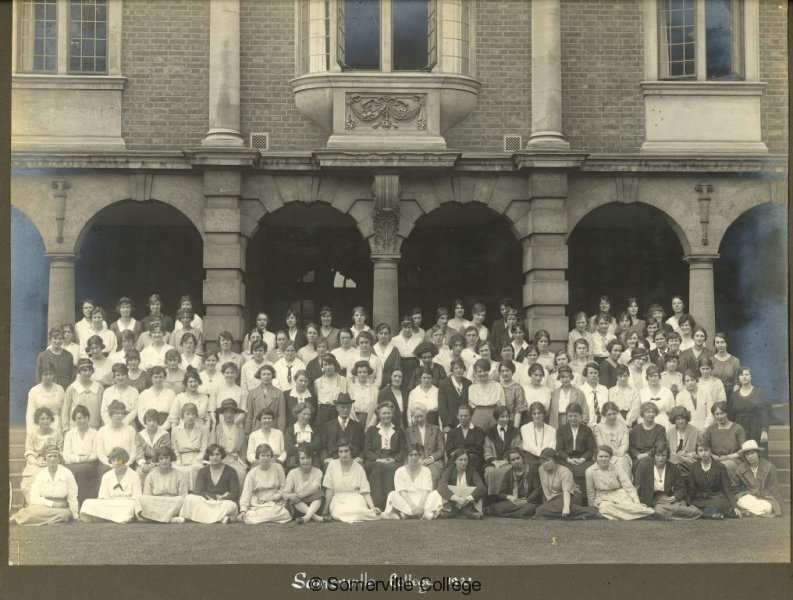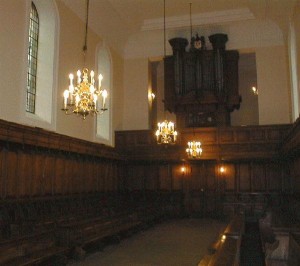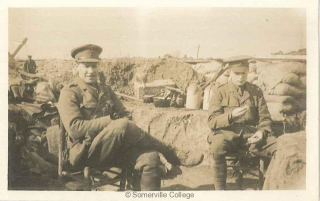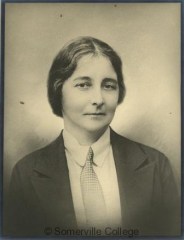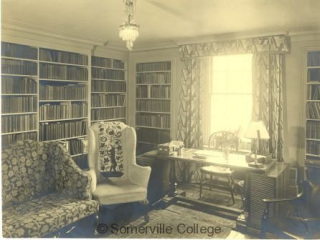The College chapel (architect Courteney Theobald) was built in 1935 following a donation from former student, Emily Kemp. However, as Somerville was specifically founded without religious affiliation, some contemporaries saw the building of a chapel as contrary to this founding principle. Construction went ahead in spite of objections but the chapel was never consecrated and its one stained glass window (designer Reginald Bell) portrays female figures representing Learning and Truth in addition to the risen Christ. The photograph above was taken shortly after construction and reflects the stark simplicity of the chapel which is retained today (below).
“A Group of Merry Oxford Girl Students”
This clipping from The Sphere in 1922 shows a group of jubilant Somerville students clutching what appear to be degree certificates outside the Sheldonian. It was only in 1920 that women were admitted as members of Oxford University and therefore able to receive degrees, so these students were some of the first women to graduate from the University. Unfortunately we have not been able to identify any individuals – unless anyone can help? The Sphere was an illustrated weekly newspaper that ran from 1900-1964 and in 1922 ran a feature on Somerville College from which this photo is taken.
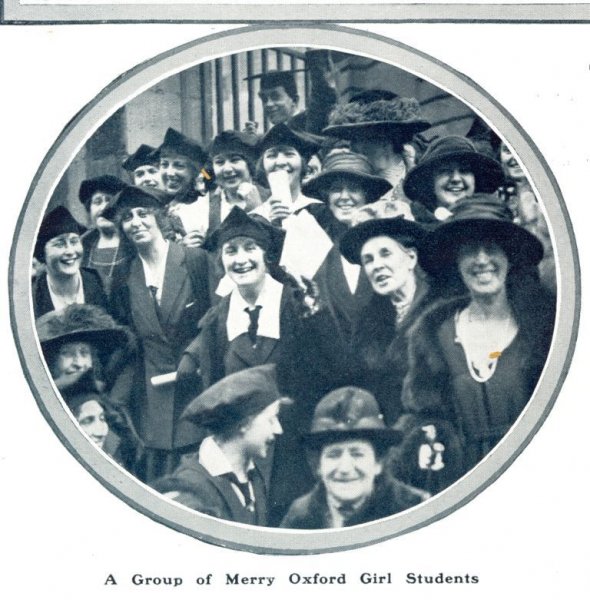
First World War Trench
This photo was taken in France during the First World War and shows on the left, Captain W S B Bosanquet. Bosanquet was an officer with the Coldstream Guards and the father of Philippa Foot, the eminent philosopher and Fellow of Somerville. Mrs Foot died in October 2010 and amongst her effects was this photo and a number of letters from her father to her grandmother, Lady Bosanquet, written from the trenches. These have now been lodged with the Imperial War Museum.
Maude Clarke
Maude Clarke was a tutor in history at Somerville from 1919 till her early death in 1935. A noted medievalist in a still largely male academic world, she published important and sometimes controversial work on fourteenth century England with a particular focus on constitutional history. We have eight of her publications in the College library but many more books that she gave the College during her sixteen year career at Somerville and on her death. One of her first pupils when she arrived at Somerville was Vera Brittain who based one of the characters in her first novel Dark Tide on Maude Clarke.
Maude Clarke was highly respected by colleagues and students for her charm, wisdom and clarity. She was particularly valued for her contributions to college governance and administration where she combined a sense of due process with a skilful tact and diplomacy.
Maude Clarke’s study in East Quad (now Darbishire) c 1934
Mrs Humphry Ward

Mary Ward (also known as Mrs Humphry Ward) was a well-known novelist in the late nineteenth century who was instrumental in the foundation of Somerville in 1879. She was the first secretary of the Somerville Council (a position jointly held with Mrs Vernon Harcourt) and worked tirelessly, preparing for the arrival of new students. It was Mary Ward who suggested that the new institution should be named after the renowned mathematician and astronomer, Mary Somerville. Although enthusiastic about education for women, she was less keen on the idea of votes for women and campaigned against suffrage in the early 20th Century , much to the dismay of many at Somerville.
Winifred Holtby and South Riding
Winifred Hotlby came to Somerville in 1917 following a period of service in France in the First World War. It was at Somerville that she met Vera Brittain 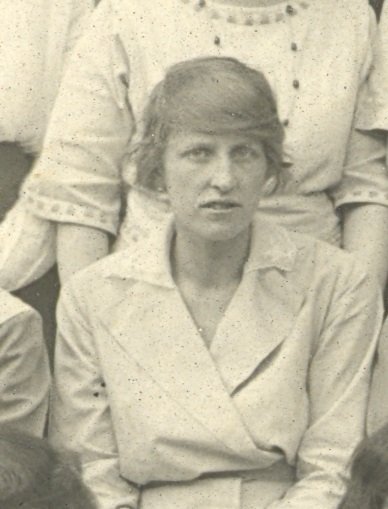 (1914 – author of Testament of Youth) and after an initial period of antagonism (fictionalised in Brittain’s first novel The Dark Tide) the two became close friends and after graduating they moved to London together to pursue literary careers.
(1914 – author of Testament of Youth) and after an initial period of antagonism (fictionalised in Brittain’s first novel The Dark Tide) the two became close friends and after graduating they moved to London together to pursue literary careers.
In 1925 Vera Brittain married George Catlin and Winifred Holtby shared their house in London, helping to care for their two children John and Shirley (the politician Shirley Williams – Baroness Williams of Crosby). Winifred Holtby continued writing novels and contributing to journals and magazines until her early death at the age of 37.
Winifred Holtby’s most famous work, South Riding was published posthumously and became an instant bestseller, providing scholarship income for Somerville for many years (a percentage of the royalties having been left to the College in her will). South Riding was first filmed in 1938 but is now the subject of a new BBC adaptation featuring Anna Maxwell Martin.
Undergraduates at Leisure 1932
 Several publicity shots were taken of Somerville life and buildings in about 1933. Here is a scene of two young ladies relaxing in a room at Somerville – perhaps one of the newly built rooms in East Quad (later renamed Darbishire) ? Does anyone recognise it as their room?
Several publicity shots were taken of Somerville life and buildings in about 1933. Here is a scene of two young ladies relaxing in a room at Somerville – perhaps one of the newly built rooms in East Quad (later renamed Darbishire) ? Does anyone recognise it as their room?
Somervillians in the First World War
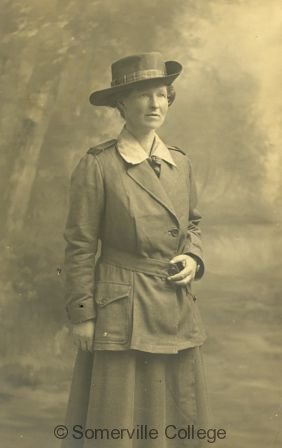
Hilda Lorimer – Classics Tutor at Somerville 1896-1934. Like many of her colleagues, Miss Lorimer divided her time during the First World War between teaching at Oxford and helping with the war effort. Here she is pictured in the uniform of the Scottish Women’s Hospital Service. She worked for them during the long vacations of 1917 and 1918 in Salonika.
Picnic on the River
A group of Somervillians and friends enjoying a day out on the river c 1925. Picture supplied by Edith Standen (1923). Any identifications gratefully accepted! 
1921 Group with Professor Gilbert Murray
A group of tutors and students from 1921 under the Principalship of Emily Penrose (seated in the second row from the front directly under the central pillar). Sitting next to Miss Penrose is Professor Gilbert Murray, noted Classical scholar, internationalist and strong supporter of women’s higher education. He was a member of the Somerville Council from 1908 to 1957 and chaired the Library Committee untill a few months before his death at the age of 91.
Members of staff are featured in the second row and include Hilda Lorimer, Emily Penrose, Alice Bruce, Mildred Pope, Maude Clarke and Vera Farnell. Unfortunately we do not have student names for this photo and we would be very interested if anyone can provide any information about them – please use the comments box below or email the library@some. ox.ac.uk 